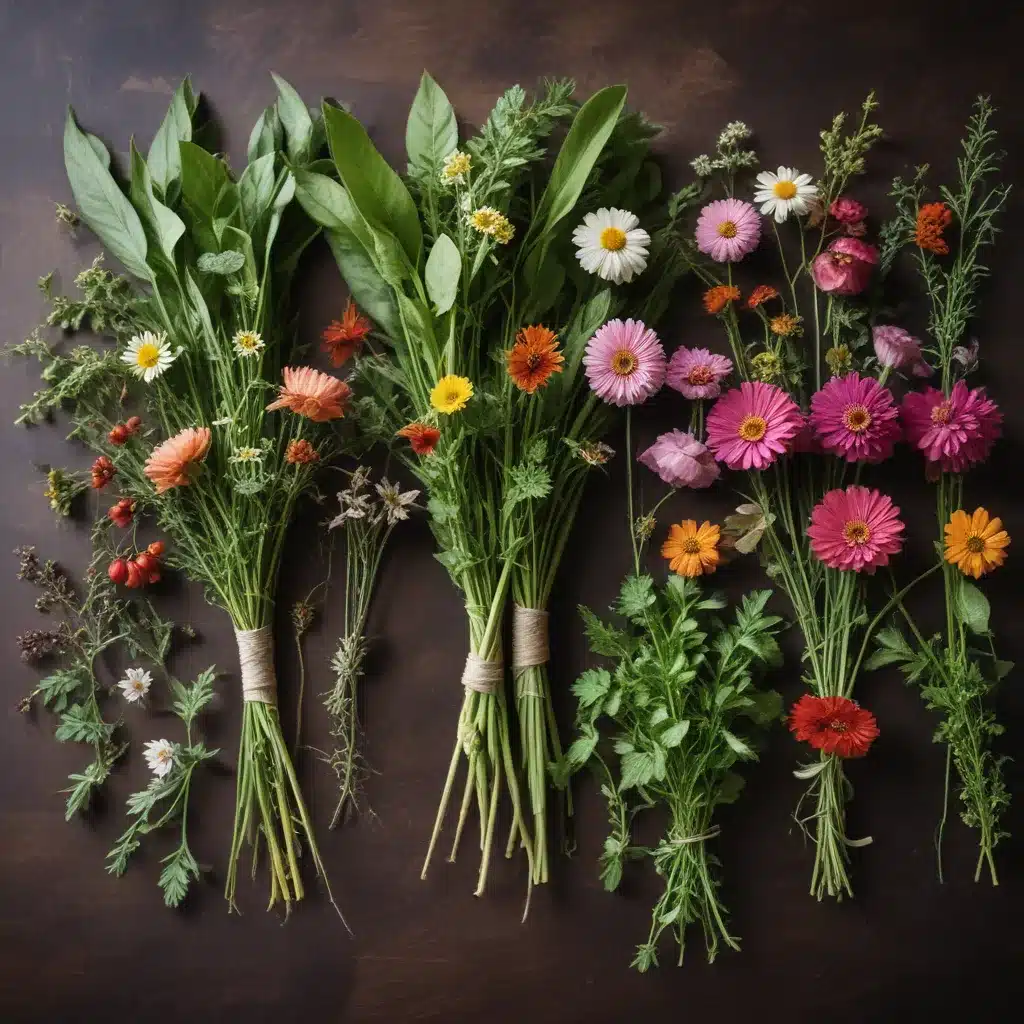
As a farm educator at Crooked Pines Farm, I’m constantly in awe of the natural world that surrounds us. From the vibrant wildflowers that dot our meadows to the aromatic herbs thriving in our gardens, the bounty of the land offers endless inspiration for creative exploration. In this article, I’ll share how you can harness the beauty and magic of foraged botanicals to craft everything from stunning floral arrangements to one-of-a-kind works of art.
Foraging for Natural Materials
Before we dive into the creative possibilities, let’s discuss the art of responsibly foraging for flowers, leaves, and herbs on the farm. Identification is key – take the time to familiarize yourself with the plants growing around you, learning their unique characteristics, habitats, and seasonal cycles. This will ensure you can safely and sustainably harvest what you need.
When foraging, always be mindful of your impact. Take only what you’ll use, leaving plenty for the plants to regenerate and for local wildlife to enjoy. Avoid areas that may be contaminated, such as roadsides or industrial sites. Instead, focus your foraging efforts in established gardens, meadows, and woodlands. Make note of which plants are thriving and which may be more delicate or rare, adjusting your harvest accordingly.
Timing is also crucial. Different botanicals will be most vibrant and flavorful at various points throughout the year. Observe the natural rhythms of your local flora, learning when flowers will be in bloom, when leaves will be lush and green, and when herbs will be at their peak.
Floral Arrangements and Bouquets
One of the simplest yet most satisfying ways to celebrate the farm’s bounty is by creating beautiful floral arrangements and bouquets. Start by considering color, texture, and form – how can you combine different floral elements to create a visually striking composition? Don’t limit yourself to just flowers; incorporate foliage, seed heads, grasses, and even herbs for depth and contrast.
Proper flower preservation is key to ensuring your creations last. After harvesting, condition the stems by submerging them in water and allowing them to rehydrate. You can also use techniques like air-drying or glycerin treatment to prolong the life of your botanical materials.
Get creative with the vessels you use to display your arrangements, too. Upcycle old jars, vases, or even hollowed-out gourds and pumpkins for a rustic, farm-inspired look. Explore different grouping and layering techniques to achieve your desired aesthetic.
Herbal Crafts and Infusions
Beyond fresh floral arrangements, the farm’s abundant herbs can be transformed into a variety of crafty keepsakes. Start by carefully drying and storing your herb harvest, ensuring they retain their vibrant colors and aromatic properties. Then, get to work crafting fragrant herbal sachets, aromatherapy candles, or even infused oils and tinctures.
Herbs aren’t just for practical uses, though – they can also serve as inspiring artistic mediums. Try your hand at pressed flower artwork, carefully arranging and preserving delicate petals, leaves, and stems. Or, experiment with herbal potpourri, blending dried botanicals with natural fixatives like orrisroot or citrus peels for long-lasting fragrance.
The Art of Botanical Collage
One of the most rewarding ways to celebrate the farm’s botanical bounty is through the art of collage. Gather an array of pressed flowers, leaves, seed pods, and other foraged elements, then let your creativity flow as you layer, arrange, and juxtapose these natural materials.
Collage is an inherently tactile and meditative practice, allowing you to fully immerse yourself in the sensory experience of the plants. Pay attention to the textures, colors, and shapes of your materials, considering how they might best complement one another on the page.
Don’t be afraid to experiment with ephemeral sculptures and installations, too. By arranging foraged botanicals in temporary displays, you can create dynamic works of art that celebrate the fleeting beauty of the natural world.
Creative Writing Inspirations
Aside from visual arts, the farm’s botanical abundance can also serve as a wellspring of inspiration for creative writing. Spend time closely observing the plants around you, taking note of their unique characteristics, aromas, and the stories they seem to tell. Then, translate these sensory experiences into evocative poetry, short stories, or personal reflections.
Consider writing poetic descriptions that capture the essence of a particular flower or herb. Or, weave foraged elements into imaginative narratives, using the natural world as a backdrop for your tales. Journaling is another wonderful way to document your mindful observations and connections with the land.
Mindful Making Practices
Ultimately, the act of crafting with foraged botanicals is a deeply mindful and therapeutic experience. By slowing down to gather, prepare, and transform these natural materials, you forge a profound connection with the rhythms of the farm. You become attuned to the seasons, the weather, and the delicate cycles of growth and decay.
Embrace this sense of presence and reverence as you create. Allow your making to be a meditation, infusing each piece with your own energy, emotions, and appreciation for the natural world. In doing so, you’ll not only cultivate beautiful, one-of-a-kind works but also nourish your own well-being and sense of belonging on the farm.
So, grab your basket and head out into the fields and gardens of Crooked Pines Farm. Let the abundance of flowers, leaves, and herbs inspire you to new creative heights, and reconnect with the land in a deeply personal way. By foraging responsibly and crafting mindfully, you’ll unlock a world of botanical wonders and carry the essence of the farm with you, even as you return indoors.


